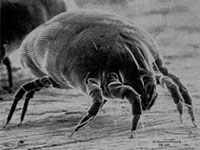Mites |
 Mites are one of the most common and successful types of insects on the planet. The number of mite species is still being determined by acarologists, scientists who study ticks and mites. There is hardly an ecologic niche that does not host a thriving population of mites. They are tiny insects that have evolved a near infinite number of survival strategies. Being so small, their needs are few. Given few available resources, a mite colony can weather harsh conditions where other insects would perish. Of course, a person's home is not a desert. Mites find survival in houses to be easy living. No matter how clean a home is, it is home to mites. There is no escaping them even though their presence has been linked to some troubling human ailments. Mite species can range in size from the visible to the microscopic. Because most of them are invisible to the naked eye, they have been hard to quantify and qualify. The known number of different types of mites now exceeds 48,000. While they can be found in open soil and water equally easily, it is mites that live in houses that most concern people. Many species of mites are parasitic in their habits. As you read this, you have microscopic mites all over your body eating dead skin, fungus, and hair oils. These rarely cause symptoms and if you hadn't read this you would never know it. The mite that causes the most concern in many people's homes is the house dust mite, a creature that is especially adapted to flourish in human habitation. This tiny insect measures less than half a millimeter. It is just barely visible when placed on a light background. Magnified, they have an appearance that can keep people awake at night. It is best not to think about them too much unless they are causing trouble in the home. House dust mites thrive in houses all over the world due the near constant temperatures maintained in most dwellings. Bedrooms are where they are of particular concern, but they live in furniture and carpets as well as kitchens, wherever they find conditions that suit them. Mattresses are their particular niche as well as pillows where the moisture from people's breath provides them with optimal humidity for their habits. As their name suggests they live off the dust in a house and the most common ingredient in household dust is shed human skin. This is what makes bedding an ideal environment. As people sleep, they shed tiny fragments of dead skin that settles into the mattress and provides a feast for house dust mites. Some people develop allergies to the waste that house dust mites produce. This can cause acute asthmatic reactions as well as chronic respiratory ailments and irritations. House dust mite waste can also irritate dermatitis in a small segment of the population. People with sensitivities to the presence of dust mites can find relief from medication. Eliminating mites from a house is nearly impossible. |
FREE QUOTE
Let's Get Started...
Save 20% By Scheduling Online...
Address
 Website Powered by BannerOS. Your Business Energized!
Website Powered by BannerOS. Your Business Energized!





